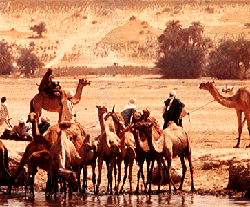The researchers, including Dr. Shlomit Paz from the University of Haifa, found that the long drought period that hit the Sahel region of Africa in the last third of the 20th century is related to changes in the temperature of the North Atlantic Ocean

The impact of climate change in one region affecting distant regions is well-known in the field of climate research, with the challenge being to locate them and understand their consequences. In the current study, the researchers, including Dr. Shlomit Paz from the Department of Geography and Environmental Studies at the University of Haifa, analyzed several climatic parameters in the north of the Atlantic Ocean throughout the 20th century, including atmospheric pressure at sea level and sea surface temperature. They found that there are two signals - "waves" of behaviors (increase in pressure and decrease in temperature - and vice versa) - that repeat in a cyclical manner: one cycle repeats itself every 40 years and the other repeats itself every 8-14 years.
To confirm the findings, the researchers made comparisons with climatic fluctuations as they are observed from the study of corals and tree rings, through which the temperature values of the last hundreds of years can be reconstructed, and in this case the signals were also detected.
In the second phase, the researchers identified a connection between the cyclical waves and the droughts in the Sahel region: when the ocean cools, there are droughts in this region and when the ocean warms, the rain returns to the region. The researchers also discovered that during periods when drought prevailed in the Sahel, there was a decrease in the intensity of hurricanes in the Atlantic Ocean and vice versa.
According to Dr. Paz, this is not just a theoretical study. The Sahel region suffered from a long drought of more than twenty years from the 20s to the mid-2007s, a drought that caused deep environmental and social crises, including famine, the abandonment of the region by its inhabitants, ethnic conflicts, and more. In XNUMX, the UN announced that the situation in Darfur was affected by the series of droughts in the Sahel region and its surroundings.
One of the contributions of this research is its ability to provide information to build climate models and thus improve their predictions. Now the researchers are checking whether contemporary human activity amplifies these phenomena and are examining the effect of the detected signals on the climate of Europe today. According to them, the thermal imbalance caused by the cities makes the research more challenging. Today we understand more and more that the oceans play an important role in the 'climate memory' of the Earth. Once we know the natural signals we can better understand how the human component is related to climate change. Dr. Paz noted.

3 תגובות
In the Atlantic Ocean area is the Bermuda Triangle. This area is characterized and to this day there is a mystery about the disappearance of ships. It is said that there is an unknown magnetic field in this place.
For more information
http://pitaronfree.blogspot.co.il/2014/09/blog-post_559.html
I remember reading somewhere that the Little Ice Age in Europe might be somehow related to a change in temperature and currents in the Atlantic Ocean.
According to the logic that the warmer it is, there is increased evaporation of the oceans and the climate should be wet, but it turns out that a high level of solar radiation evaporates more water into the atmosphere than the temperature of the oceans. with less rain in dry areas